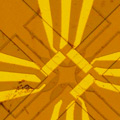Characterizing photoelectrons with quantum point contacts:
Electron billiards in nanoscale circuits
19.10.2010, Press releases
In solar cells, solar radiation boosts electrons to higher energy states, thereby releasing them from their atomic bonds as electricity begins to flow. Scientists led by Professor Alexander Holleitner, physicist at the Technische Universität Muenchen (TUM), have developed a novel method to analyze the way photogenerated electrons move in the smallest photodetectors. They present the fruits of their research in the current issue of the magazine Nano Letters.
At the heart of the method is a so-called quantum point contact (QPC). This is a narrow conductive channel in a semiconductor circuit. The scientists created a 70-nanometer narrow channel, about as wide as the wavelength of electrons in the semiconductor. The key is that only one electron at a time will fit through the channel, making possible extremely high-precision measurements of the electric current. As described in the current publication, this method was applied to photogenerated electrons for the first time ever.
In the experimental set-up it is not the sun, but rather a laser beam that kicks the electrons into their excited state. These electrons are then analyzed using a quantum point contact. In the process, the scientists were able to demonstrate for the first time that photogenerated electrons can flow several micrometers before colliding with crystalline atoms. They also established that the geometric form of a circuit has a strong influence on electron paths. Electrons can even “run around corners” when they rebound from circuit boundaries, not unlike billiard balls.
The insights and analytic opportunities made possible by this novel technique are relevant to a whole range of applications. These include, most notably, the further development of electronic components such as photodetectors, high electron mobility transistors (HEMT), and components that utilize the magnetic spin of electrons to process information.
Apart from Professor Holleitner’s team, scientists working with Professor Joerg Kotthaus (Ludwig-Maximilians-Universitaet Muenchen) and Professor Peter Haenggi (Universitaet Augsburg) participated in the research. The studies were funded by the Cluster of Excellence Nanosystems Initiative Munich (NIM), the German Federal Ministry of Education and Research BMBF via nanoQUIT, the Deutsche Forschungsgemeinschaft (DFG Grant no. Ho 3324/4), the Center for NanoScience (CeNS), and LMUexcellent.
Publication:
Spatially resolved ballistic optoelectronic transport measured by quantized photocurrent spectroscopy, Klaus-Dieter Hof, Franz J. Kaiser, Markus Stallhofer, Dieter Schuh, Werner Wegscheider, Peter Hänggi, Sigmund Kohler, Jorg P. Kotthaus und Alexander W. Holleitner; Nano Lett., 2010, 10 (10), pp 3836–3840
Contact:
Prof. Dr. Alexander Holleitner
Technische Universitaet Muenchen
Physics Department
James-Franck-Str. 1, 85748 Garching, Germany
Tel.: +49 89 289 12775 - E-Mail - Internet
Kontakt: presse@tum.de
More Information
| 101019_elektronenbillard_pw.pdf |
Druckversion der Presseinformation (DE),
(Type: application/pdf,
Size: 130.8 kB)
Save attachment
|




